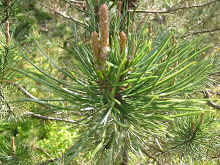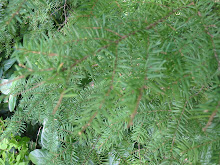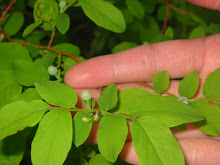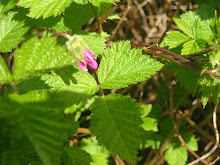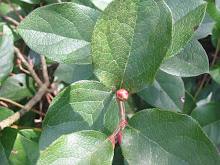can do…begin it
First and Most Important Question: Why should we change?
What is purpose for rejecting the status quo?
High School Biology in British Columbia is a survey course. Students are encouraged to systematically study life cycles, and the gross anatomy of protazoa, bacteria, fungi, plants and invertebrate animals. Major themes include evolution and ecology. Biology courses tend to be reductionist. Every phylum is dissected in both lecture and lab, in form of a (preserved) specimen sectioned, pinned and labeled.
Ironically, there is little practical natural history in the curriculum. Students recite the inner parts of vascular plants, but they could not recognize Vine Maple, Huckleberry, Swordfern and Labrador tea, native forest understory plants
in their local forest. They could draw the life cycle of Sphagnum Moss, yet fail to see the significance of sphagnum in their very own neighbourhood bog: Camosun Bog, of Pacific Spirit Park.
I first fell in love with Camosun Bog when I lived within two blocks of it. I noticed that the air was unusually fresh. It wasn’t just my imagination: Sphagnum moss, in bogs, act as carbon sinks that are even more efficient than old growth forests. The air really was more pure in the bog. There were always interesting fauna there: a woodpecker, hummingbird, or owl, and at night, a chorus of frogs. They would all stop croaking at once if you rudely walked in on their nocturnal courtship and couplings. Then one by one they would start singing again, under a canopy of stars.
At the time, I did not realize that the sphagnum at the heart of the Bog ecosystem was endangered and slowly being competed out by the hemlock forest around it. The bog is like a living fossil, containing arctic starflower, a rare plant almost never found below arctic latitudes.
I propose that biology changes into a place-based course. A course that grounds “learning in a sense of place through the study of local knowledge and the investigation of surrounding natural and human communities” (Smith and Williams, 1999, P.8). In our learning outcomes for biology, we should include the “development of personal affinity with the earth through practical experiences out-of-doors and through the practice of an ethic of care.” (Smith and Williams, 1999, p.7).
Why care for Camosun Bog? Students can learn about ecology, plant competition, and plant anatomy with this bog as their classroom. In fact, all the kingdoms of life are found within Camosun bog, so the place can become an organizer for the course. This classroom has the added benefit of being more stimulating for the senses than most indoor classrooms.
The most compelling reason to preserve the bog is its role as a carbon sink. Camosun bog’s significance is more than simply local. My students can act as stewards of the bog, weeding out the invasive species, getting their hands and feet dirty with the peat laid down a millennia ago. And they can gain an appreciation of this place that contributes to the reduction of greenhouse gasses in the lower mainland. Thus by learning about and caring for the bog, they can contribute to caring for the earth itself.
Question 2: What implementation challenges prevent us from changing?
Teachers have limited experience with fieldwork. They lack the time to familiarize themselves with the primary flora and fauna. There is the logistical problem of the working around a school timetable, which does not leave large blocks of time for fieldwork. Finally, there is the practical problem of public washrooms. There are none in the bog.
The pace of the present secondary school biology course favours classroom lectures over field excursions. The cost-benefit analysis of changing the course into a place-based, field course is “High benefit- high cost”. (Werner, January 24, 2006). The benefits include having a moral purpose, an inspiration, ownership and stewardship of the environment. Another benefit is the opportunity to collect data as a field observer, as a scientist. But the cost would include reducing classroom time for traditional detailed lectures, and possibly reducing “content”.
The mandated content is a powerful constraint against local, place-based knowledge. “Could it be that the educational structures that currently constrain environmental education are the product of the same cultural outlook that has created our environmental problems?” (Smith and Williams, 1999, p. 61). The following diagram from Smith and Williams, p. 61 illustrates this point:
MANDATED EMERGENT
ß-----------------------------------à
MONOCULTURE DIVERSITY
The mandated curriculum is easy to test, using standard textbooks regardless of place. A place-based curriculum invites students to learn about the local flora and fauna and their ecological interactions. Complexity is inevitable when field observation rather than the textbook is the primary source of information. Fullan’s “eight lessons” for change encourages this kind of emergent learning, especially in lesson one “You Can’t Mandate What Matters” and in lesson seven “Connection with the Wider Environment is Critical for Success” (Fullan, 1993)
Question 4: What Aspects of School Culture prevents change?
Core pedagogies: the timetable does not lend itself to change. The format of the coursework and the sheer breadth of the curriculum make a lecture and reading format unavoidable. The culture of academic achievement makes students afraid to miss academic classes for fear of losing content from Chemistry, Physics and Math. In Biology, dissection is the primary method for observing specimens. We “murder to dissect” by losing all appreciation for the “specimen”. A shift from dissection to fieldwork would be a second order change. The most important constraint from a cultural standpoint is the mandated curriculum itself. But considering that the BC biology course is presently not provincially examined through standardized tests, just where does the pressure come from to cover all the content?
Question 3: What attitudes and underlying assumptions of teachers hinder implementation?
fieldwork takes time away from lectures, labs and exams. When given a choice, some teachers will choose an exam over field studies out of necessity.
This year, the school administration encouraged teachers to eliminate final exams and replace them with a field trip: Fort Langley, Bard on the Beach, Britannia Beach Mining Museum. English, Social Studies and Fine Arts departments eagerly agreed with this change. Math and science teachers resisted, fearing the loss of academic standards.
Or dream you can…
Question 5: What is the plan for change?
Implementation strategies: Use the dynamic view of change (Werner, January 24, 2006) to introduce a succession of ideas over time: Small incremental change that initially has a high benefit and low cost. The first year, make a field trip to visit the bog. Add lessons annually so change is incremental and manageable. In the second year add data collection. In the third year, make presentations to the local elementary school. In every year, participate in the Saturday weeding parties. The work parties are organized by community volunteers. If we simply join in then we benefit from expertise and training. After each incremental change, examine, debrief, discuss and make new plans. (Werner, 2002). Then, if there is success, momentum can build and the project can take on energy and life from the enthusiasm of students. (See test run, below).
Attempt to work with the culture, at least at first:
It would be too much to ask to change the timetable entirely to suit the bog project. A small move would be to request the biology classes are placed back to back so it would be easier for the teacher to meet and dismiss students. Strategies can be adopted from the Physical Education classes. P.E. goes on many field trips using public transit and early dismissal slips: swimming, skating, hockey etc. Use their methods of meeting and dismissal for fieldwork.
Strategies to deal with teacher attitudes towards field studies: Teachers’ personal beliefs and assumptions are difficult to change. I will not attempt it. It would be a major philosophical shift to challenge the idea that the test should not wag our curriculum. An alternative is to tailor the field studies to fit into the mandated curriculum. Practicality, after all is one of the characteristics of a successful innovation so the bog field trips should be congruent with the way our teachers teach.(Werner, January 24, 2006).
Therefore, propose the idea that the bog is a useful organizer for learning Kingdom Plantae. Students need to learn the life cycle of the moss. Relate this life cycle to the bog and the species of moss important in it. At this stage in considering change, the school will respond to a low cost – high benefit strategy of teaching to the test using the bog as a classroom and an organizing factor. As the project gains momentum, as authentic learning experiences emerge, the academic benefits will be evident. Above all, invite colleagues to take a walk in the bog. If the bog casts its spell on them, then a passion for the place might be all they needs to see its importance.
Whatever you can do or dream you can, begin it…
Test Run in 2005:
In the spring of 2005, I brought two biology 11 classes out to Camosun Bog to have a field trip. Members of the Camosun Bog Restoration Society led small groups through parts of the bog, some parts were fully restored, others were in transition. It was only one day. The local elementary school allowed me use of their washroom facilities. The students were able to see the rare species contained within the bog for themselves, though they did not collect any data.
Furthermore, I invited students to sign up for Saturday work parties, where they had the opportunity to get their hands dirty weeding out invasive species, everything from skunk cabbage, ferns and grass to huge stumps that required much effort and strength.
My work party students learned the most from their experiences. They worked hard, weeding out ferns and skunk cabbage, or pruning pine trees. They met others who cared for the bog, a retired engineer, a marketing instructor, an 82 year old man who grew up near the bog, and who told stories of the local history of the bog (the fire, the draining of the bog, bog hockey games). One student fell knee deep into the peat. She discovered that she just stepped through thousands of years of sphagnum layers.
The students who signed up for the work parties invited their friends along: a girl from another school, a friend and that friend’s boyfriend. I brought snacks and drinks to sustain them through the mucky work. There was a sense of community as everyone worked for a common purpose. At least one student continued volunteering, and another found a tutor through the experience. Last week, my school was attempting to encourage teachers to adapt their existing lessons to the new portfolio requirement for graduation. I realized that my bog project could fall under a category of community service and I prepared a plan that fit with the portfolio requirements. (Appendix 1) For some reason, environmental awareness, and caring for the environment were themes that were noticeably absent from the portfolio requirements.
This year, I hope to build on my experiences and contacts from 2005, to add the fieldwork to the field trip and to gain more weekend “boggers”. It is a small start, a shift in the equilibrium of the way I teach biology. Hopefully it is the initial energy required to help the curriculum spiral into a new complex curriculum of place emerging from the present monoculture.
Whatever you can do or dream you can, begin it. boldness has genius, power and magic in it
J. W.V. Goethe
Appendix I
Camosun bog Project As It Relates To the Portfolio Requirements
Appendix II (See the other attachment to the email)
Camosun Bog Power Point Presentation given to Students in 2005.
Note, this power point presentation was also submitted to Dr. Gaalen Ericksen in a Science Education Course relating to complexity in science education. My ideas regarding using the bog as a biology classroom began in this course. Eventually the Camosun Bog Project could become my Graduation Project for my M. Ed.
References:
Fullan, M, Change Forces, Bristol, PA: Falmer, 1993.
Werner, Walter, “ “Talking” Our Way Into Educational Change: A Canadian View”, Chulalongkorn Educational Review, vol 9 No. 1 July, 2002
Werner, Walter, “Understanding Educational Change”, Department of Curriculum Studies, UBC, Lectures January-April, 2006
Smith, Gregory and Williams, Dilafruz, Ecological education in Action, State University of New York Press, 1999









